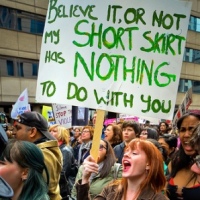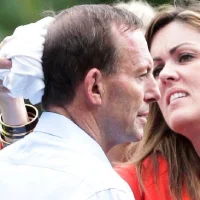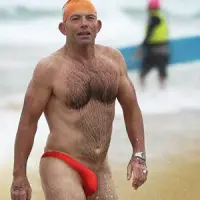Yesterday, author and playwright Van Badham wrote this piece in The Guardian titled “The moral case for gambling,” in which she considers the role class plays in the current campaign to curtail gambling opportunities through legislation. Van Badham writes:
Given the popularity of gambling in this country, I wonder if the public shaming of Australian gamblers has more to do with bourgeois loathing of working-class habits than any genuine moral crusade for public good. It must be very confusing for those who base their social self-esteem on the accumulation of money to witness a pastime that involves the happy sacrifice of it.
I do recommend reading the piece. It’s caused some controversy, and raises points worth considering.
In 2011 I wrote this piece for The Drum, titled “Pornography, the Internet and class”. I’m republishing it here in full, because it seems to me many of the questions I pose are compatible with the current prevailing attitude to gambling. I’m not suggesting the two are interchangeable, however I agree with Van Badham that class does indeed play a significant role in determining prevalent attitudes, and this is a factor we probably need to be aware of when considering legislation.
Pornography, the Internet and class. The Drum, September 8 2011
It seems reasonable when faced with strident action against social mores to require those opposing them to put forward their preferred alternative.
In the case of anti-pornography activists, it’s apparently impossible to persuade them to offer a framework of how they think sexuality ought to be expressed. Like Opposition Leader Tony Abbott they just say no, without proffering any other policies.
Viewed in the best light, anti-porn activism is a cri de coeur for the protection of women who some activists believe are exploited and degraded by the very existence of pornography; for the protection of children who may access internet content they are emotionally ill-equipped to process, and for the prevention of possible individual psycho-sexual harm that might interpolate itself into the fabric of society.
At its worst anti-porn activism is an attempt to control and shape the culture to fit particular religious, ideological and/or moral agendas. The moral entrepreneurs who are at the vanguard of the anti-porn movement are overwhelmingly middle class, and it is from a middle class platform that they launch campaigns that express the horror, disgust and outrage evoked in them by pornography, as well as what they believe to be its ruinous effects on sexual relations.
All pornography is positioned by activists as deviant, regardless of the content. It’s extremely difficult to ascertain just what their range of “normal” sexuality includes. One activist, Professor Clive Hamilton, refuses to use the word “vagina” when attempting to describe close-ups of “well, I don’t know what” in early editions of Playboy, for example. Many would find this male squeamishness towards female genitalia offensive. Are we to regress to such euphemisms as “down there?”
Those who produce, create and consume pornography are perceived as deviants who must be rescued, punished when appropriate, and hopefully redeemed to participate in non-pornographic sex. Global eradication of anything other than “normal” is the goal, without ever stating just what that “normal” might be.
Accounts written by activists of what they have seen in their forays into the netherworld of porn are like dispatches from Dante’s second circle of Hell:
The new porn zeitgeist is hard-core sadism. Hard-core porn turns misogyny into sexual fascism and sells it as freedom. There are countless “18 and abused” sites showing young girls being gang-banged while crying, drunk, vomiting, with guns and knives to their heads. Incest porn with girls being bashed about sexually by fathers, grandfathers, uncles, brothers. There is bestiality porn with dogs, horses, with eels. Torture porn, where young women are tied up and strangled, defecated on. There is Nazi fetish porn, lots of racist porn.
Feminised gay men being beaten and anally raped by hyper-macho gangs. Granny porn where older women are subjected to the now compulsory triple penetration and spat on for being old. There is even “retarded asian porn”, “retarded and horny”, “full on retard porn . . . legless sluts being triple penetrated”, amputee porn, dwarf porn, anorexia porn.
In this account of internet porn by academic Dr Abigail Bray the porn world is entirely comprised of victims. Young girls, women, grandmothers, feminised men, and animals are subjected to horrific violence, and all of it done to them by men.
I haven’t viewed any of these sites. Taking Dr Bray’s descriptions at face value and imagining myself part of such a world feels unspeakably awful, but that’s my personal reaction, not a universal absolute. Pornography is an expression of the vast and sometimes very frightening range of human sexuality, whether I like it or not.
It isn’t made clear if the victims (other than children and animals) have been forced to participate in these acts, but it is an assumption with which the reader initially co-operates. The description asserts “countless sites” depicting such pornography, so there must be correspondingly “countless” numbers of adult human beings engaging in its production, either by choice or under severe duress.
Who are these human beings and how did they arrive in the Second Circle? As yet there’s no comprehensive answer to those questions. Women who work in hardcore porn are, unsurprisingly, resistant to inquiries by outsiders.
Women who have consented to interviews disassociate themselves from the kind of porn Dr Bray describes. They also express considerable aggravation with anti-porn activists, who they feel are insulting and patronising. They accuse anti-porn activists of making life more difficult for them by portraying them as psychologically sick, morally bad, victimised, and in need of rescue. In so doing, the women claim, activists are in fact supporting porn producers in their opinion of the women they hire as disturbed, and highly exploitable. They also feel unfairly lumped in with women who endure more extreme hardcore violations. In the pecking order of the porn world, some women are proud of the choices they make and resentful of those who see them as part of a homogenous victimised mass.
Activists put forward hypotheticals in an effort to explain why women participate in violent and degrading porn. For example, they claim they are frequently women who were sexually abused as children. They are women who have developed high levels of tolerance for abuse, and have “abnormal” attitudes that permit them to accept degradation and violence others would find abhorrent. They are women who can’t or believe they can’t obtain employment in any other field. They are poor women, uneducated women, ignorant women. They are women who have sustained such damage that the question of choice doesn’t even arise: they don’t know that they are suffering because they have lost or never had the ability to recognise abuse.
There is little research available to confirm or deny these assumptions. The hypotheticals originate from middle-class sexual morality and values, and/or religious beliefs about women and sexuality. There is often little attention paid to the social and political contexts in which the alleged early life abuses take place, or the economic systems that cause female poverty. This lack of analysis could lead to accusations of attempting to treat the symptoms while ignoring the cause, always an exercise in futility.
Assumptions about women who perform in porn need to be investigated through empirical research before they can be evaluated, rather than accepting classist, moralistic and religious prejudices as a basis for public policy. As things stand, a deviant underclass is constructed by anti-porn activists, against which the moral values of middle classes voices raised in protestations of “isn’t it awful” and “what about our children” can be reassuringly measured. This is not helpful.
Very little hardcore porn is currently produced in Australia. There is not much home-grown activists can do to rescue women in sovereign nations that do produce it, and many of those countries already have legislation against some if not all the violence that is acted out.
However, activists are concerned that hardcore porn is easily accessed on the internet and is inserting itself into everyday Australian life. It’s claimed that a degradation of sexual values inevitably occurs, particularly amongst young people, many of whom are allegedly taking their sexual education from sites such as those described by Dr Bray, and enacting loveless, violent and genital-focused sex that uses women as objects for male gratification, and not as equal participants in a mutually satisfying act.
Anti-porn activist and academic Gail Dines claims that 11-year-old boys are viewing violent porn that “deforms their minds,” though she offers no research to substantiate this claim. If 11-year-old boys are accessing hardcore internet porn, the responsibility for that must rest with their parents, who also bear the responsibility for offering their children intelligent sex education. Presumably middle-class parents are considered more likely to do this, so are Dines and her followers referring to lower status families who apparently can’t be trusted to do the right thing? Where do Dines’ porn-consuming 11-year-olds come from? She doesn’t reveal the demographic.
Many activists such as Clive Hamilton see the problems presented by the internet as a matter for the state. They want internet censorship. In other words, the state must assume the role of disseminator of middle-class religious and ideological sexual values, by imposing a ban on anything that class considers deviant and polluting. The activists apparently do not trust parents, or at least parents of a lower socio-economic class to monitor their children’s internet adventures, for example with software that will filter content on the home computer. They argue that this responsibility belongs with government, and they seem to be entirely oblivious to the dangers of giving any government control over what its citizens may and may not view in the privacy of their own homes.
An Australian internet filter will do nothing to assist women who are unwillingly enslaved by pornography producers. It quite likely will exclude innocent sites, or be easily bypassed. The proposed list of banned sites is itself banned from public scrutiny, and that restriction alone should give us serious cause for alarm. As the link also reveals, there are already strict if somewhat mysterious classification laws in place in Australia.
But activists need to justify their existence, to show effectiveness, and to win respect from their peers. In this situation, the only possible measure of their “success” will be an internet filter. Their message is: you can have a sexual life like ours if you follow our sexual rules, (though we have yet to be told what they are) and our Government will help you do that by forbidding you access to anything else. This places the Government’s authority above God’s: at least God apparently permits free will, and the right to go to hell any way one chooses.
As the late Susan Sontag, American author, feminist, literary theorist and political activist, put it in her 1967 essay The Pornographic Imagination:
If so many are teetering on the verge of murder, dehumanisation, sexual deformity and despair, and we were to act on that thought, then censorship much more radical than the indignant foes of pornography ever envisage seems in order. For if that’s the case, not only pornography but all forms of serious art and knowledge – in other words, all forms of truth – are suspect and dangerous.







































Recent Comments